Protocol 3.1: Produce the IPC Analysis Report
At the conclusion of the analysis process, the analysis team should draft the key messages to be included in the Analysis Report. The report should be finalized and shared as soon as possible, e.g. preferably within one or two months from the completion of the analysis. The completed Report should contain the minimum information, as per Table 29.
IPC Modular Communication Template
The IPC Modular Communication Template provides a standard format and content guide for developing IPC Analysis Reports. The Template has been developed to meet the different interests and needs of a variety of IPC stakeholders while ensuring that the minimum requirements for communicating IPC results are met. By using the modular template, IPC Analysis Reports effectively communicate key findings in a clear, concise, accessible and consistent format.
The Modular Communication Template for Chronic Food Insecurity includes: (i) Key facts and messages; (ii) Classification maps and the Summary Population Table; (iii) Situation overview, key drivers and limiting factors; (iv) Recommendations for action; (v) Detailed Population Table(s); (vi) Process, methodology and data sources; (vii) Results in figures; (viii) Limiting factors and key drivers -matrix; and (9) Profiles of the most affected areas/groups.
General guidelines for completing the Communication Template include the following:
- All modules of the template should be completed. At a minimum, the full IPC Analysis Report should include Modules 1 to 6; Modules 7 to 9 are optional.
- Modules can be selected and combined to develop specific products that meet the needs of different stakeholders. (See Box 64 for examples of selection of modules for different audiences.)
- Modules are designed to ensure consistent IPC branding as well as ownership. Key information should be provided. For example, the name of the country, contacts, institution hosting the IPC, resource partners and logos of the analysis partners should be clearly communicated.
- The IPC Modular Communication Template can be developed in the ISS or offline.
- The use of the IPC Modular Communication Template does not prevent countries from producing further documents or incorporating IPC results in other documents.
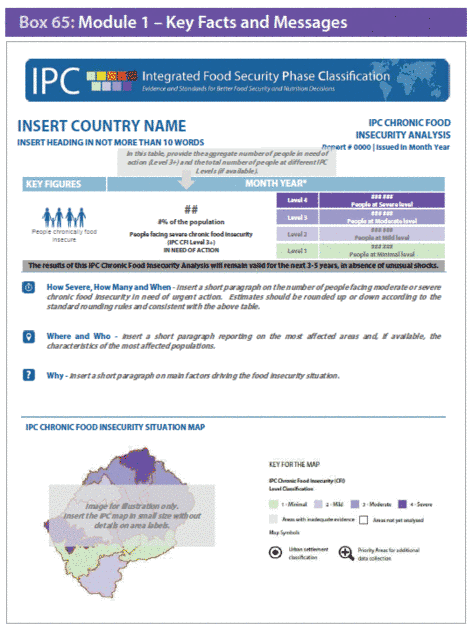
Module 1: Key facts and messages
Purpose. To provide concise responses to the key five questions: how severe, how many, where, who and why (Box 65).
Key information to be included:
- Aggregated population estimates: Provide the aggregate number of people in need of action (Level 3+) and the total number of people at different IPC levels (if available).
- How many and how severe: Refer to the number of people facing moderate or severe chronic food insecurity in need of urgent action.
- Where and who: Identify the most affected areas and, if available, the characteristics of the most affected populations.
- Why: Insert a short paragraph on the main factors driving the food insecurity situation.
- Situation map: Include small IPC maps without details on area labels.
Note that, in this module, population estimates in the first page (how many) should be rounded up or down according to the standard rounding rules; for example, analysts may choose to round to the nearest 5 percent and/or to the nearest one thousand (‘000) people.
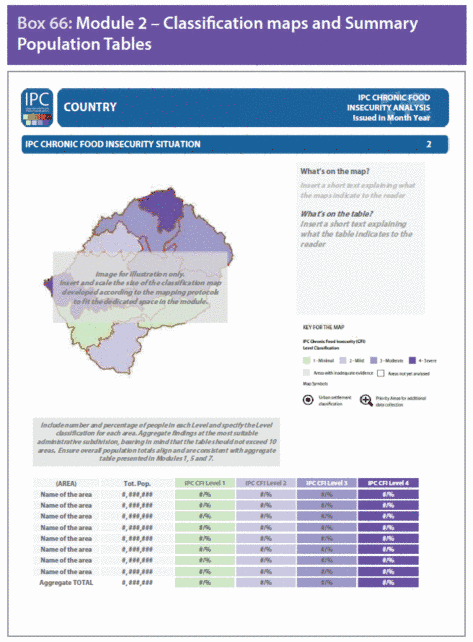
Module 2: Classification maps and Summary Population Tables
Purpose. To provide larger-scale, more detailed classification map and summary table of the population estimates (Box 66).
Key information to be included:
- Classification map: Include and scale the size of the classification map developed according to the mapping protocols to fit the dedicated space in the module. Insert a short text explaining what the maps indicate to the reader.
- Summary population tables: Use the template or develop a summary population table to be added below the map. Include the number and percentage of people in each level, and specify the level classification for each area. Aggregate findings at the most suitable administrative subdivision level, bearing in mind that the table should not exceed ten areas (consider aggregating by regions if needed). Ensure that overall population totals align and are consistent with aggregate table presented in Modules 1, 5 and 7 (if developed).
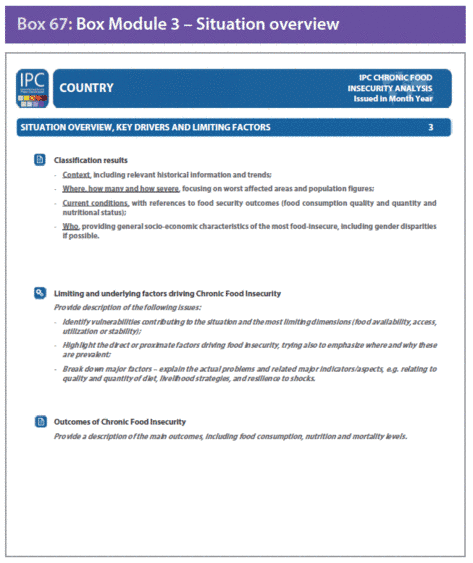
Module 3: Situation overview, key drivers and limiting factors
Purpose. To provide more detailed analysis of classification to answer the five key questions of how severe, how many, where, why, and who (Box 67).
Key information to be included:
- Classification results, considering:
- context, including relevant historical information and trends;
- where, how many and how severe, focusing on most severely affected areas and population figures;
- current conditions, with references to food security outcomes (food consumption quality and quantity and nutritional status);
- who, providing general socio-economic characteristics of the most food-insecure, including gender disparities if possible;
- Limiting and underlying factors driving chronic food insecurity: Provide a description of the main drivers of chronic food insecurity:
- Identify vulnerabilities contributing to the situation and the most limiting dimensions (food availability, access, utilization or stability).
- Highlight the direct or proximate factors driving food insecurity, and emphasize where and why they are prevalent.
- Break down major factors – Explain the actual problems and related major indicators/aspects, for example, relating to the quality and quantity of diet, livelihood strategies and resilience to shocks.
- Outcomes of chronic food insecurity: Provide a description of the main outcomes, including food consumption, nutrition and mortality levels. (See Box 68 for an example of a situation overview.)
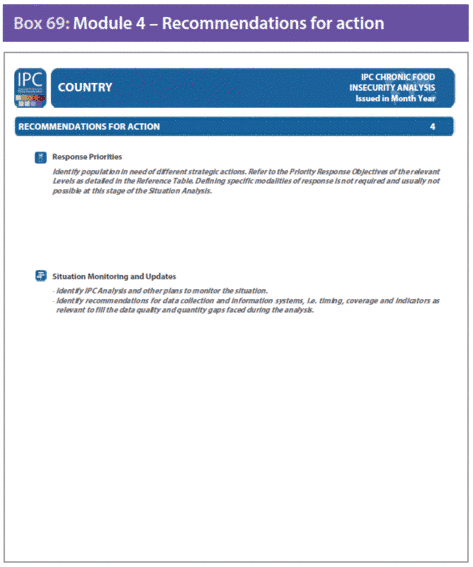
Module 4: Recommendations for action
Purpose. To provide general recommendations for: (i) response priorities; (ii) situation monitoring activities; and (iii) the data collection and information system (Box 69).
Key information to be included:
- Response priorities:
- Identify the populations in need of different strategic action. Refer to the priority response objectives of the relevant levels as detailed in the Reference Table. Defining specific modalities of response is not required and usually not possible at this stage of the Situation Analysis.
- Situation monitoring and update:
- Identify plans for food security monitoring and any upcoming IPC Analyses.
- Identify recommendations for data collection and information systems, i.e. timing, coverage and indicators as relevant to fill the data quality and quantity gaps faced during the analysis.
Module 5: Detailed Population Table
Purpose. To develop and share the population estimates for different IPC levels (Box 70).
Key information to be included:
- Overview of methods for population estimates:
- A brief methodological note on how the populations were estimated. Focus should be on the evidence-based consensus-building nature of the method where the prevalence of direct (and indirect) evidence is used to estimate the likely distribution of people between the four severity levels.
- Population Table:
- Develop a detailed Population Table for all areas analysed, disaggregated at relevant administrative level or other unit used in the analysis.
- Include total population, number and percentage of people in different levels and the aggregate number and percentage of people in Levels 3 and 4 for each area.
- The percentage in each level should be calculated in relation to population analysed (e.g. if only rural populations are classified, then the total population should refer to the rural population).
- Specify the classification level for each area analysed.
- When using ISS, the Population Table will be generated automatically.
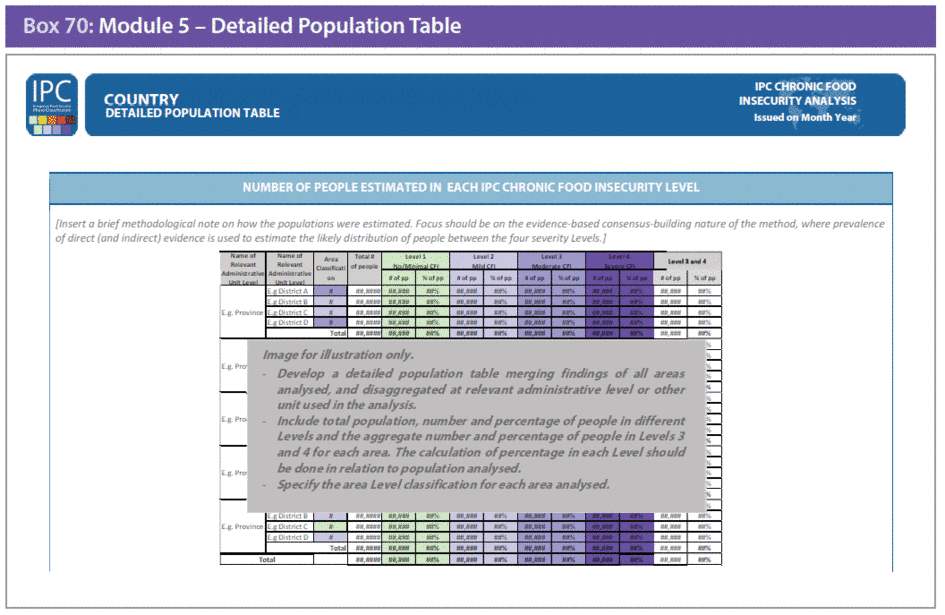
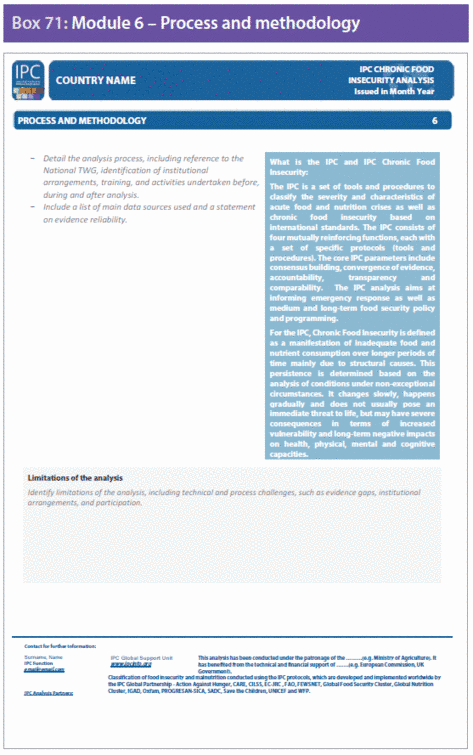
Module 6: Process and methodology
Purpose. To describe the IPC approach, analysis process, main data sources and key limitations (Box 71).
Key information to be included:
- Process and methodology
Detail the analysis process, including reference to the National Technical Working Group, identification of institutional arrangements, training, and activities undertaken before, during and after analysis.
Include a list of main data sources used and a statement on evidence reliability.
- Identify limitations of the analysis, including technical and process challenges, such as evidence gaps, institutional arrangements and participation.

Module 7: Results in numbers
Purpose. To present key results in easily accessible infographics (Box 72).
Key information to be included:
A graphic visual representation of the most important results/information of the IPC analysis, specifically:
- The IPC map and legend.
- Population figures: Insert the aggregate number of population in Levels 3 and 4 rounded as in Module 1; insert the total number of population analysed; develop a pie chart to represent the percentage of analysed population in each level; and break down the population figures in the different levels rounded as in Module 1.
- Most affected areas and respective population estimates in the most severe level: For the most affected areas, aggregate findings at the most suitable administrative subdivision level, bearing in mind that the layout can accommodate a maximum of ten main areas. For each area, provide the number of population in Levels 2, 3 and 4, if available.
- Major limiting factors: Indicate in how many areas food availability, food access and food utilization are limiting factors.
- Major drivers: Decide on four to six drivers to highlight in the infographic, write them down and add the appropriate icons/images as well as any numbers/figures if available.
- Key outcomes: Decide on the most important outcomes to highlight in the infographic (quality of food consumption, quantity of food consumption, nutrition status) through number(s) and icon(s).
Module 8: The Limiting Factors and Key Drivers Matrix
Purpose. To provide an overview of the key drivers and limiting factors triggering existing levels of chronic food insecurity (Box 73).
Key information to be included:
- Use the table provided in the module to indicate the major, minor and no limiting factors and key drivers as well as no data availability per area.
- Use ISS to complete the table.
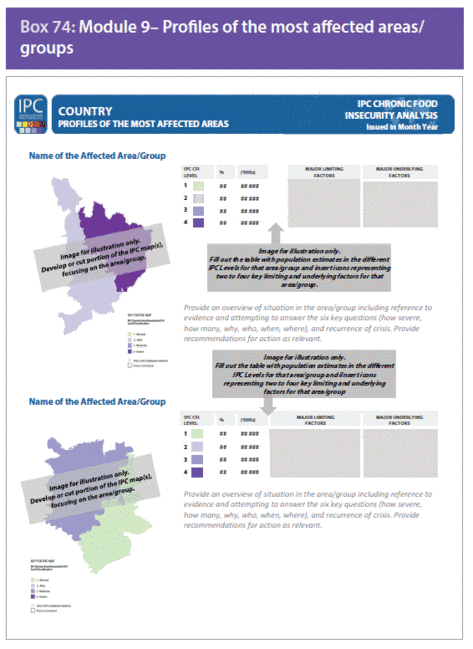
Module 9: Profiles of the most affected areas/groups
Purpose. To present key findings for the most affected areas/groups, especially IPC Levels 3 and 4 (Box 74).
Key information to be included:
- an overview of the situation in the area/group including reference to evidence and answers to the five key questions (how severe, how many, why, who, where) and recurrence of crisis;
- recommendations for action as relevant:
- Develop or cut a portion of the IPC map(s), focusing on the area/group.
- Fill out the table with population estimates in the different IPC levels for that area/group.
- Insert icons representing two to four key limiting factors and key drivers for that area/group.